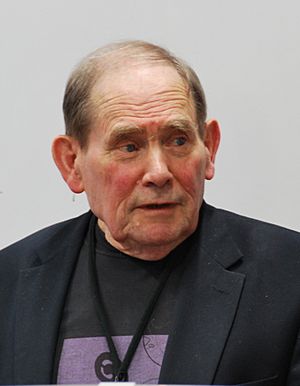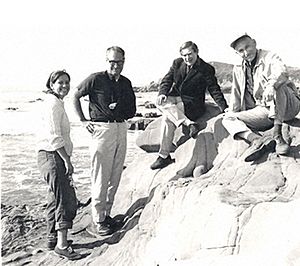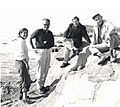Sydney Brenner facts for kids
Quick facts for kids
Sydney Brenner
|
|
|---|---|
 |
|
| Born | 13 January 1927 Germiston, Transvaal, Union of South Africa
|
| Died | 5 April 2019 (aged 92) |
| Other names | Uncle Syd |
| Citizenship | South Africa |
| Alma mater |
|
| Known for | Genetics of Caenorhabditis elegans |
| Spouse(s) |
May Covitz
(m. 1952; |
| Children | 3 |
| Awards |
|
| Scientific career | |
| Fields | Biology |
| Institutions |
|
| Thesis | The physical chemistry of cell processes: a study of bacteriophage resistance in Escherichia coli, strain B (1954) |
| Doctoral advisor | Cyril Hinshelwood |
| Doctoral students | |
| Influences | Fred Sanger |
| Influenced | Toby Gibson |
Sydney Brenner was a famous South African biologist. He was born on 13 January 1927 and passed away on 5 April 2019. In 2002, he won the Nobel Prize in Physiology or Medicine. He shared this important award with H. Robert Horvitz and Sir John Sulston.
Brenner made huge discoveries about the genetic code and how living things develop. He did much of his work at the Medical Research Council (MRC) Laboratory of Molecular Biology in Cambridge, England. He also helped make the tiny roundworm a key animal for studying developmental biology.
Contents
Early Life and Schooling
Sydney Brenner was born in Germiston, South Africa, in 1927. His parents, Leah and Morris Brenner, were Jewish immigrants. His father was a cobbler from Lithuania, and his mother came from Latvia.
Sydney went to Germiston High School. He started university at the University of the Witwatersrand when he was only 15 years old. Because he was so young, he wouldn't be old enough to become a doctor after his medical course. So, he first studied for a Bachelor of Science degree in Anatomy and Physiology.
He continued his studies, earning an MSc degree. To support himself, he worked part-time in a lab. Later, he received a scholarship that allowed him to study for his Doctor of Philosophy (DPhil) degree at the University of Oxford in England.
Discoveries in Science
After finishing his DPhil, Brenner worked at the University of California, Berkeley. He then spent 20 years at the MRC Laboratory of Molecular Biology in Cambridge. Here, he made many important contributions to molecular biology, which was a new field at the time.
Seeing the DNA Model
In April 1953, Sydney Brenner was one of the first people to see the new model of DNA's structure. This model was built by Francis Crick and James Watson. Brenner was very impressed by it. He later worked with Crick at the University of Cambridge.
Understanding the Genetic Code
Brenner made several key discoveries about the genetic code. This code is like a set of instructions that tells cells how to build proteins.
- No Overlapping Codes: He showed that the genetic instructions could not overlap each other. This was a big step in understanding how genes work.
- The Adaptor Hypothesis: In 1955, Brenner suggested there was a special molecule that would transfer genetic information. This molecule was later found and called transfer RNA (tRNA). It acts like an "adaptor" between the genetic code and the proteins being made.
- Messenger RNA (mRNA): In 1960, Brenner helped discover messenger RNA (mRNA). mRNA carries the genetic message from DNA to the parts of the cell that make proteins.
- Triplet Code: With his colleagues, Brenner showed that the genetic code is read in groups of three "letters" (nucleotides). These groups are called triplets. This discovery was very important for understanding how proteins are made.
The Tiny Worm: C. elegans
Sydney Brenner then decided to study a small, free-living roundworm called Caenorhabditis elegans. He chose this worm to learn about how animals develop, especially their nervous systems.
He picked this worm because it is tiny (about 1 millimeter long) and easy to grow. It was also good for studying genes. By studying worms with problems, like being "uncoordinated," scientists could find new proteins important for development.
For his work with C. elegans, Brenner shared the 2002 Nobel Prize in Physiology or Medicine. He called the worm "Nature's Gift to Science." Many scientists around the world now study C. elegans because of Brenner's pioneering work.
Later Career and Influence
In 1996, Brenner started the Molecular Sciences Institute in Berkeley, California. He was also involved with several other important research institutes around the world, including the Salk Institute for Biological Studies and the Okinawa Institute of Science and Technology.
Brenner was known for his sharp mind and sense of humor. He wrote a popular column called "Loose Ends" in a science journal. He also wrote books about science, sharing his ideas and inspiring many young scientists.
Awards and Special Recognition
Sydney Brenner received many awards for his amazing contributions to science. Some of these include:
- Fellow of King's College, Cambridge (1959)
- Fellow of the Royal Society (1965)
- Albert Lasker Medical Research Award (1971)
- Royal Medal (1974)
- National Academy of Sciences member (1977)
- Gairdner Foundation International Award (1978 and 1991)
- Kyoto Prize (1990)
- Copley Medal (1991)
- King Faisal International Prize in Medicine (1992)
- The Nobel Prize in Physiology or Medicine (2002)
- Dan David Prize (2002)
In his honor, a type of orchid was named Dendrobium Sydney Brenner. Also, another type of roundworm was named Caenorhabditis brenneri. In 2008, the University of the Witwatersrand named the Sydney Brenner Institute for Molecular Bioscience (SBIMB) after him. In 2019, a new species of bobtail squid, Euprymna brenneri, was also named in his honor.
Personal Life
Sydney Brenner was married to May Brenner from 1952 until she passed away in 2010. They had three children. He lived in Ely, Cambridgeshire, England. He was an atheist.
Sydney Brenner passed away in Singapore on 5 April 2019, at the age of 92.
Images for kids
-
Esther Lederberg, Gunther Stent, Sydney Brenner and Joshua Lederberg pictured in 1965
See also
 In Spanish: Sydney Brenner para niños
In Spanish: Sydney Brenner para niños




